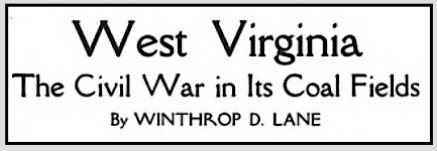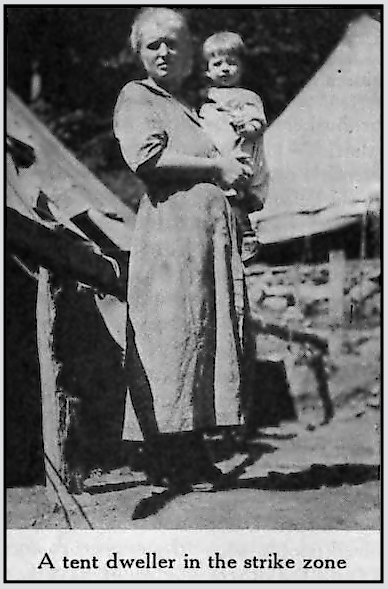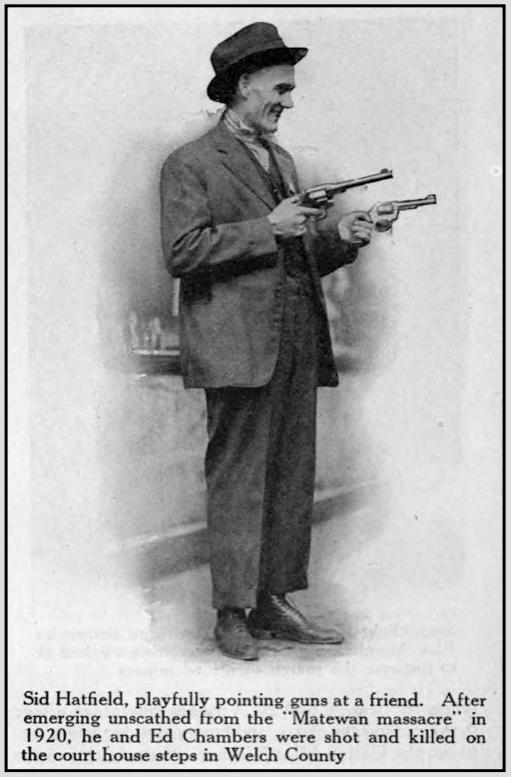 —————
—————
Hellraisers Journal – Monday October 31, 1921
Winthrop D. Lane on West Virginia’s Coal Field War, Part II
From The Survey of October 1921:
[Part II of III.]
Throughout the country today the bituminous coal fields are largely organized. Soft coal is produce in some twenty states. Such large coal-producing areas as Ohio, Indiana, Illinois and Western Pennsylvania have almost solidly accepted the union. The United Mine Workers of America is a relatively advanced element of the American labor movement. Its national body has demanded the nationalization of the coal mines and certain districts have begun to demand a share in the maintenance and control of production. Among the most important non-union fields are the Connellsville section in Pennsylvania, another strip along the Allegheny River, the Alabama fields, Utah, and these non-union areas of West Virginia. Bit by bit the union has succeeded in wresting one section after another of West Virginia. Bloody scenes have marked this progress at intervals. Today approximately half of the 95,000 miners in the state are members of the union. The unorganized portions are concentrated, for the most part, in the five counties of Logan, Wyoming, Mercer, McDowell and Mingo.
Who are the operators in this district that are so hostile to unionism? Not as much is known about the ownership of coal lands in West Virginia as might be. Some clue to the forces back of the struggle is gained, however, from the fact that the United States Steel Corporation is one of the largest owners of non-union coal land. Subsidiary companies of the corporation own 53,736 acres of coking coal land and 32,648 acres of surface coal land in Logan and Mingo counties combined, according to its annual report for 1919. In the Pocahontas field—chieflyMcDowell, Mercer and Wyoming counties—the corporation leases, through subsidiaries, 63,766 acres of the best coking and fuel property. The Norfolk and Western Railway Company, which traverses the Pocahontas field, is also heavily interested in coal lands in these parts. It owns nearly every share of the Pocahontas Coal and Coke Company, a leasing company, on whose lands upward of twenty-five mining companies operate. The Norfolk and WesternRailway Company is commonly understood to be controlled by the Pennsylvania Railroad. There are, of course, other large owners and many smaller ones. The resident owner is not scarce, but a great deal of the land in these regions is owned by absentee holders, living in other states and the large cities.
None the less, the West Virginia operators allege that a conspiracy exists, and has existed for years, between the United Mine Workers of America and the union operators of Ohio, Indiana, Illinois and Western Pennsylvania to organize the non-union mines of their state. The purpose of this conspiracy, they say, is to compel them to accept competition on an equal basis with the union fields in spite of their own geographical isolation, surrounded on nearly all sides as they are by mines nearer the large industrial markets.
The West Virginia employers, moreover, back up their stand by saying that the public interest demands that a portion of the coal land of the country remain non-union, so that in the event of a national strike of miners there may be some source of coal to keep the nation from freezing to death.
The fight is not, therefore, a local struggle merely. It is a fight between huge combinations of capital and resources, on the one hand, and one of the largest and most aggressive of labor unions, on the other. It is a fight between two different industrial philosophies, for the steel trade is the stronghold of anti-unionism in American industry and the Pennsylvania Railroad has taken, at times, a belligerent attitude toward railroad labor organizations.
The operators have sought the courts in their efforts to stem the union’s activities in West Virginia. Today injunctions protect nearly the whole of Mercer and McDowell counties against encroachment by the union; no union organizer or representative can enter those counties with the message of unionism on his lips without danger of arrest. Individual contracts with their employes have also been resorted to by the operators—the “yellow dog” contracts of union phraseology—whereby the men bind themselves not to “join or belong to” any mine labor organization “so long as the relation of employer and employe exists.” These contracts have been used especially in Mercer and McDowell counties.
A further means of relief at the hands of the law has been sought by the operators, to be used in the event that some of their men should actually join the union. They have set up the contention that the relation between the employer and the employe, in regard to the house which the miner rents from the coal company, is not that of landlord and tenant, but that of master and servant. The object of this is to permit them not only to discharge a man who joins the union, but to put him out of his house as well. A large number of evictions have occurred under this interpretation of relationships and their effect has been to render all of the miners and their families comprising about one-fourth of the state’s population, insecure in their right to domicile. The miner have no shelter that is not subject to immediate confiscation. The houses owned by the coal companies are the only ones there are to live in.
Other methods to oppose the union have been used. That deputy sheriffs are paid by the operator is both admitted and defended by the employer themselves. No less an authority than the attorney general of the state, E. T. England, says that “every one knows that one of the duties of these deputies is to keep the union out.” The use of agents of the Baldwin-Felts Detective Agency and “under-cover” men is now well established. Precisely what resort is had to “armed guards,” men who are employed privately by the operators and equipped with guns on the understanding that they are to keep away all agents of the union, is not clear. That this has been the practice in the past in a few, at least, of the non union districts, was the unequivocal statement to me of T. L. Lewis, now secretary of the New River Coal Operators’ Association and formerly an official of the union [former President of the United Mine Workers of America]. Many of the deputy sheriffs are, of course, no other than armed guards in effect. Extravagant statements are sometimes made by the union in regard to the number of such persons employed by the operators, but it is clear that here is a kind of opposition that keeps men in constant fear for their personal safety and that the union will never cease agitating for the riddance of what it regards as a direct threat to the physical welfare of its representatives.
The acts of such armed men are not easy to control. The operators may say, of course, that they have never planned or ordered assaults on union organizers or men who “talked unionism,” but such assaults have been committed, nonetheless. A commission appointed by former Governor Cornwell two years ago to inquire into conditions in Logan County secured ample evidence that union agents and sympathizers had been beaten up and injured by deputy sheriffs in that county. Affidavits have been given to the Senate Committee on Education and Labor charging that a union bricklayer from Huntington was shot in cold blood in the jail in Logan County on September 1 by two deputy sheriffs, one of the witnesses alleging that the act was committed not three feet from his cell.
Union miners have resorted to violence in their turn. There have been carefully planned attacks on the property of non-union coal companies and on persons identified with hostility to the union. Mingo County has been the scene of much violence of this sort. Guerilla warfare, made comparatively safe by the topography of the country, which is marked by wooded hills overlooking open, narrow valleys, has raged intermittently for over a year. In this warfare shots have been fired by both sides.
The possession of arms is no secret. “We had some bad luck,” I overheard a person identified with the side of the miners say. “Some guns that were meant for our fellows at _____ were put off at the wrong station and the other side got ’em.” In Logan county an operator showed me his “arsenal.” The county authorities throughout the non-union districts are, in a sense, commanders of small garrisons. They can mobilize and equip scores, if not hundreds, of men on short notice.
[Emphasis added.]
~~~~~~~~~~~~~~~~~~~~
SOURCES & IMAGES
Quote Mother Jones, June 20, 1920, Speeches Steel p213
https://books.google.com/books?id=vI-xAAAAIAAJ
https://digital.library.pitt.edu/islandora/object/pitt%3A31735035254105/viewer#page/1/mode/2up
The Survey, Volume 47
(New York, New York)
-Oct 1921 to Mar 1922
Survey Associates, 1922
https://archive.org/details/surveycharityorg47survrich/page/2/mode/2up
https://babel.hathitrust.org/cgi/pt?id=uc1.31210013389174&view=2up&seq=7&skin=2021
-Oct 29, 1921-page 178:
“West Virginia, Civil War in Its Coal Fields” by WD Lane, Part II
https://archive.org/details/surveycharityorg47survrich/page/178/mode/2up
See also:
Hellraisers Journal: From The Survey:
“West Virginia, The Civil War in Its Coal Fields” by Winthrop D. Lane, Part I
Tag: Winthrop Lane
https://weneverforget.org/tag/winthrop-lane/
Civil War in West Virginia
-by Winthrop David Lane
B. W. Huebsch, Incorporated, 1921
https://books.google.com/books?id=3hYtAQAAIAAJ
https://archive.org/details/civilwarinwestvi00lanerich/page/n7/mode/2up
https://catalog.hathitrust.org/Record/001432266
Tag: Mingo County Coal Miners Strike of 1920-1922
https://weneverforget.org/tag/mingo-county-coal-miners-strike-of-1920-1922/
~~~~~~~~~~~~~~~~~~~~~~~~~~~~~~~~~~~~~~~~
Battle of Blair Mountain – Louise Mosrie



